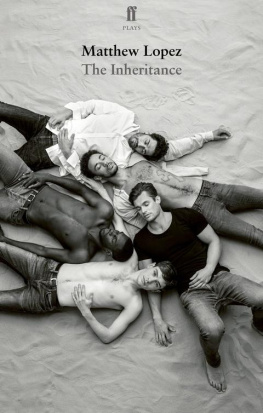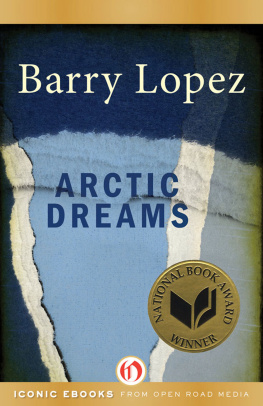Acclaim for BARRY LOPEZs
About This Life
[Barry Lopez] can bring the light of an arctic summers midnight to your living room.
The Columbus Dispatch
Lopez writes with a photographers keen eye, a novelists sure-handed way with detail and a biologists attention to scientific accuracy.
Newsday
About This Life is a shimmering window on the richness of the world [and] the vagaries of memory.
Portland Oregonian
Whether he is visiting remote islands or sites closer to home, Lopez provides a sincere look at what is marvelous about his surroundings, and his book admirably adds to what he calls a literature of hope.
Chicago Tribune
Curiosity, fresh insight, and luminous, precise prose is generously on display here.
The Philadelphia Inquirer
Lopez is a careful and caring writer he truly shows us the worlds magic.
Seattle Post-Intelligencer
[Lopez has] that rarest of keen eyes, the one that can home in on the face in the mirror and see truly.
The Denver Post
BARRY LOPEZ
About This Life
Barry Lopez is the author of six works of nonfiction, including Arctic Dreams and Of Wolves and Men; six works of fiction, including Field Notes and Winter Count; and a novella-length fable, Crow and Weasel. His work appears regularly in Harpers, where he is a contributing editor, as well as in The Paris Review, Orion, The Georgia Review, Outside, and elsewhere. The recipient of numerous literary awards, including the National Book Award for nonfiction, he lives in western Oregon.
Also by
BARRY LOPEZ
NONFICTION
Arctic Dreams
Of Wolves and Men
FICTION
Lessons from the Wolverine
Field Notes
Crow and Weasel
Winter Count
River Notes
Giving Birth to Thunder, Sleeping with His Daughter
Desert Notes
ESSAYS
Apologia
The Rediscovery of North America
Crossing Open Ground
VINTAGE BOOKS EDITION, MAY 1999
Copyright 1998 by Barry Holstun Lopez
All rights reserved under International and Pan-American Copyright
Conventions. Published in the United States by Vintage Books, a division
of Random House, Inc., New York. Originally published in hardcover
in the United States by Alfred A. Knopf, Inc., New York, in 1998.
Vintage Books and colophon are registered
trademarks of Random House, Inc.
The Library of Congress has cataloged
the Knopf edition as follows:
Lopez, Barry Holstun, [date]
About this life / Barry Lopez. 1st American ed.
p. cm.
eISBN: 978-0-307-80650-5
1. Lopez, Barry Holstun, [date]Biography.
2. Authors, American20th centuryBiography.
I. Title.
PS3562.067Z464 1998
813.54dc21
[B] 9814257
Author Photograph Nancy Bennett Evelyn
www.randomhouse.com/vintage
v3.1
For Mary Holstun Lopez
for Adrian Bernard Lopez and John Edward Brennan
for Sidney Van Sheck and Dara Emery
and for my brother, Dennis Holstun Lopez
CONTENTS
PART ONE
Out of Country
PART TWO
Indwelling
PART THREE
Remembrance
PART FOUR
An Opening Quartet
Introduction
A VOICE
I WAS BORN east of the heights of New Rochelle in the watershed of New Yorks Mamaroneck River in the winter of 1945. In the spring of 1948 my father, a billboard advertising executive, would move us away, to a home in rural California at the foot of the Santa Susana Mountains in the San Fernando Valley, far from this suburban landscape just thirty miles from New York City. I would never know why. Perhaps the move was an effort to save a marriage gone awry, or maybe he hoped to capitalize on prospects in southern California after the war.
For a long time I thought of California as the beginning, the place where my life took a distinctive shape, but something had already begun. When I recall incidents from those first three years in New York, some still vivid as a bowl of oranges on a summer windowsill, several seem to bear directly on my later life, to be adumbrations. Or perhaps that is only how memory works.
We lived on the second floor of a six-story apartment building situated on Orienta Point in the town of Mamaroneck. It faced onto Mamaroneck Harbor, an embayment of Long Island Sound. My parents, avid sailors, had a membership in the Nanhook Yacht Club, which was affiliated with The Orientaa primary attraction for people who chose to live there.
A great lawn sloped north from the building down to a seawall and a narrow beach, off which sailboats were moored. My earliest memories are of crawling off a blanket onto this cool, prickly turf under a huge elm. Flower beds had been planted along the buildings east side, and I remember walking in them with my mother to pick flowers as tall as I was. I remember the aroma of the soil in summer and the way the bare earth puckered to a dry crust after an early morning watering.
The odor and the flowers colors in the garden attracted me. To ensure visits there with Mother, Id sometimes line my alphabet blocks up on a windowsillour windows were right above the gardensand push them out. Shed take me along to retrieve them while she gathered bouquets.
I also remember the glare of light on the harbor and the snap of white sails coming taut in a breeze. In warm weather I was closely watched like other children on the beach, but I recall wading out into the water as if I were alone, and wanting to go farther. I could see across to Shootfly Island and the estuary of Otter Creek. Away to the east, where Turkey Rock and Hen Island stood out, lowlying Peningo Neck protected the harbor from the open waters of the Sound.
Standing in seawater stirred to wavelets by the wind, my head thrown back, Id turn slowly to gaze at the towering crown of the elm, backlit and twinkling in noon light, turn and catch the long horizon of the sound to the east, keep turning to follow scudding sailboats on that wind. On the hottest days I sought out the shade of the big elm, but I would go back in the water again to experience that peculiar yearningto swim, to sail, to go. I would wait in the water for something to emerge, to appear in that empty space above its surface.
Shortly after my brother was born in 1948, my father drove out to California. My mother and brother and I flew west afterward in a Constellation. (I remember a living-room-like atmosphere at the rear of this plane, where couch seats were arranged in a horseshoe around a table, and going into the terminal at Love Field in Dallas with one of the stewardesses to eat dinner while my mother attended to my infant brother.) My parents divorced two years later, and my mother began raising us with a dedication I would not understand or appreciate for years. She taught home economics during the day at a junior high school; twice a week she taught night school at a junior college. She also worked at home as a dressmaker.


















